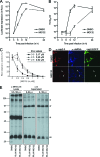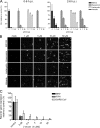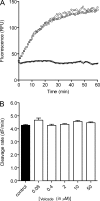The ubiquitin-proteasome system plays an important role during various stages of the coronavirus infection cycle
- PMID: 20484504
- PMCID: PMC2897594
- DOI: 10.1128/JVI.00485-10
The ubiquitin-proteasome system plays an important role during various stages of the coronavirus infection cycle
Abstract
The ubiquitin-proteasome system (UPS) is a key player in regulating the intracellular sorting and degradation of proteins. In this study we investigated the role of the UPS in different steps of the coronavirus (CoV) infection cycle. Inhibition of the proteasome by different chemical compounds (i.e., MG132, epoxomicin, and Velcade) appeared to not only impair entry but also RNA synthesis and subsequent protein expression of different CoVs (i.e., mouse hepatitis virus [MHV], feline infectious peritonitis virus, and severe acute respiratory syndrome CoV). MHV assembly and release were, however, not appreciably affected by these compounds. The inhibitory effect on CoV protein expression did not appear to result from a general inhibition of translation due to induction of a cellular stress response by the inhibitors. Stress-induced phosphorylation of eukaryotic translation initiation factor 2alpha (eIF2alpha) generally results in impaired initiation of protein synthesis, but the sensitivity of MHV infection to proteasome inhibitors was unchanged in cells lacking a phosphorylatable eIF2alpha. MHV infection was affected not only by inhibition of the proteasome but also by interfering with protein ubiquitination. Viral protein expression was reduced in cells expressing a temperature-sensitive ubiquitin-activating enzyme E1 at the restrictive temperature, as well as in cells in which ubiquitin was depleted by using small interfering RNAs. Under these conditions, the susceptibility of the cells to virus infection was, however, not affected, excluding an important role of ubiquitination in virus entry. Our observations reveal an important role of the UPS in multiple steps of the CoV infection cycle and identify the UPS as a potential drug target to modulate the impact of CoV infection.
Figures






Similar articles
-
Proteasome inhibition in vivo promotes survival in a lethal murine model of severe acute respiratory syndrome.J Virol. 2010 Dec;84(23):12419-28. doi: 10.1128/JVI.01219-10. Epub 2010 Sep 22. J Virol. 2010. PMID: 20861244 Free PMC article.
-
Severe acute respiratory syndrome coronavirus replication is severely impaired by MG132 due to proteasome-independent inhibition of M-calpain.J Virol. 2012 Sep;86(18):10112-22. doi: 10.1128/JVI.01001-12. Epub 2012 Jul 11. J Virol. 2012. PMID: 22787216 Free PMC article.
-
The ubiquitin-proteasome system facilitates the transfer of murine coronavirus from endosome to cytoplasm during virus entry.J Virol. 2005 Jan;79(1):644-8. doi: 10.1128/JVI.79.1.644-648.2005. J Virol. 2005. PMID: 15596861 Free PMC article.
-
Viral entry and the ubiquitin-proteasome system.Cell Microbiol. 2021 Feb;23(2):e13276. doi: 10.1111/cmi.13276. Epub 2020 Oct 26. Cell Microbiol. 2021. PMID: 33037857 Review.
-
The ubiquitin-proteasome system (UPS) and the mechanism of action of bortezomib.Curr Pharm Des. 2011;17(15):1483-99. doi: 10.2174/138161211796197124. Curr Pharm Des. 2011. PMID: 21504411 Review.
Cited by
-
COVID-19 Usurps Host Regulatory Networks.Front Pharmacol. 2020 Aug 14;11:1278. doi: 10.3389/fphar.2020.01278. eCollection 2020. Front Pharmacol. 2020. PMID: 32922297 Free PMC article. Review.
-
Protein homeostasis in aging and cancer.Front Cell Dev Biol. 2023 Feb 16;11:1143532. doi: 10.3389/fcell.2023.1143532. eCollection 2023. Front Cell Dev Biol. 2023. PMID: 36875752 Free PMC article. Review.
-
Determination of host proteins composing the microenvironment of coronavirus replicase complexes by proximity-labeling.Elife. 2019 Jan 11;8:e42037. doi: 10.7554/eLife.42037. Elife. 2019. PMID: 30632963 Free PMC article.
-
The Superimposed Deubiquitination Effect of OTULIN and Porcine Reproductive and Respiratory Syndrome Virus (PRRSV) Nsp11 Promotes Multiplication of PRRSV.J Virol. 2018 Apr 13;92(9):e00175-18. doi: 10.1128/JVI.00175-18. Print 2018 May 1. J Virol. 2018. PMID: 29444948 Free PMC article.
-
Multiple E3 ligases act as antiviral factors against SARS-CoV-2 via inducing the ubiquitination and degradation of ORF9b.J Virol. 2024 Jun 13;98(6):e0162423. doi: 10.1128/jvi.01624-23. Epub 2024 May 6. J Virol. 2024. PMID: 38709105 Free PMC article.
References
-
- Anand, K., J. Ziebuhr, P. Wadhwani, J. R. Mesters, and R. Hilgenfeld. 2003. Coronavirus main proteinase (3CLpro) structure: basis for design of anti-SARS drugs. Science 300:1763-1767. - PubMed
-
- Berlanga, J. J., J. Santoyo, and C. De Haro. 1999. Characterization of a mammalian homolog of the GCN2 eukaryotic initiation factor 2α kinase. Eur. J. Biochem. 265:754-762. - PubMed
-
- Bieniasz, P. D. 2006. Late budding domains and host proteins in enveloped virus release. Virology 344:55-63. - PubMed
Publication types
MeSH terms
Substances
LinkOut - more resources
Full Text Sources
Other Literature Sources
Research Materials

